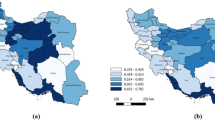Abstract
We formulate a mixed-integer program that can be used to analyze the decision between centralized and decentralized technologies for new energy infrastructure development. The formulation minimizes the cost of meeting both average and peak power demand in each specified demand node. We demonstrate our methodology with a case study of Rwanda, accounting for existing generation and transmission infrastructure. Thirteen ongoing or proposed projects are considered as potential new centralized generation facilities and the decentralized technology is modeled after a small (\(\sim \)50 W) solar home system. The case study is repeated using population data at four different resolutions while varying demand levels and decentralized technology cost. A tipping point effect is observed, where the optimal infrastructure tips from being primarily centralized to primarily decentralized under certain combinations of the demand and cost parameters. These tipping points are largely consistent across the four data resolutions. Finding a solution within 1 % of optimal was often found to be computationally expensive in formulations with greater than approximately 200 nodes and 800 edges. However, formulations using less dense population data are shown to accurately identify the same tipping points while requiring fewer computational resources. Examples of the minimum cost electricity infrastructure in Rwanda are also shown for several specific combinations of parameters.









Similar content being viewed by others
References
Rosenberg, W.: Deploying IGCC in this decade with 3Party Covenant Financing: volume I. Belfer Center for Science and International Affairs, Kennedy School of Government, Harvard University, Cambridge, Massachusetts, Discussion Paper 2004–2007, May 2005
Black and Veatch: 20 percent wind energy penetration in the United States: a technical analysis of the energy resource, Black and Veatch Report Number 144864, October 2007
Katzer, J.: The future of coal: options for a carbon-constrained world. Massachusetts Institute of Technology, Cambridge (2007)
Lazard Ltd.: Levelized cost of energy analysis—version 2.0, June 2008
Du, Y., Parsons, J.E.: Update on the cost of nuclear power. Center for Energy and Environmental Policy Research, Massachusetts Institute of Technology, Cambridge, Massachusetts, 09-004, May 2009
Borin, S., Levin, T., Thomas, V.: The Levelized cost of electricity generation technologies: reducing the role of forecasting for capital and fuel costs, Submitted for review to Applied Energy (2012)
Branker, K., Pathak, M.J.M., Pearce, J.M.: A review of solar photovoltaic levelized cost of electricity. Renew. Sustain. Energy Rev. 15(9), 4470–4482 (2011)
Singh, P.P., Singh, S.: Realistic generation cost of solar photovoltaic electricity. Renew. Energy 35(3), 563–569 (2010)
Joskow, P.L.: Comparing the costs of intermittent and dispatchable electricity generating technologies. Am. Econ. Rev. 101(3), 238–241 (2011)
Parshall, L., Pillai, D., Mohan, S., Sanoh, A., Modi, V.: National electricity planning in settings with low pre-existing grid coverage: development of a spatial model and case study of Kenya. Energy Policy 37(6), 2395–2410 (2009)
Zvoleff, A., Kocaman, A.S., Huh, W.T., Modi, V.: The impact of geography on energy infrastructure costs. Energy Policy 37(10), 4066–4078 (2009)
Deichmann, U., Meisner, C., Murray, S., Wheeler, D.: The economics of renewable energy expansion in rural sub-Saharan Africa. Energy Policy 39(1), 215–227 (2011)
Levin, T., Thomas, V.M.: Least-cost network evaluation of centralized and decentralized contributions to global electrification. Energy Policy 41, 286–302 (2012)
Columbia University Center for International Earth Science Information Network (CIESIN) and Centro Internacional de Agricultura Tropical (CIAT): Gridded Population of the World Version 3 (GPWv3): Land Area Grids. Socioeconomic Data and Applications Center (SEDAC), Columbia University, Palisades (2010)
Modi, V., McDade, S., Lallement, D., Saghir, J.: Energy Services for the Millennium Development Goals, Energy Sector Management Assistance Programme, United Nations Development Programme, UN Millennium Project, and World Bank, New York (2005)
Koch, W.: Solar panels power 1 million Bangladesh homes, USA Today, 15 June 2011
Grameen Shakti: Grameen Shakti Solar Home System Price List, 2009. http://www.gshakti.org/index.php?option=com_content&view=article&id=115&itemid=124
Lahmeyer International: Analysis and projection of Rwanda’s electricity demand, LI 260160, May 2004
REMA: Rwanda State of Environment and Outlook Report. Rwanda Environment Management Authority, Kigali (2010)
Safari, B.: A review of energy in Rwanda. Renew. Sustain. Energy Rev. 14(1), 524–529 (2010)
Africa Development Bank: Boosting Rwanda’s Energy Sector—AfDB, Other Lenders Commit Usd 91.25 Million to Kivuwatt Project”, All Africa, Kigali, Rwanda, 26 August 2011
Uwamahoro, Y.: Rural electrification in Rwanda, Kigali, Uganda, 12 July 2010
Rwanda Utilities Regulatory Agency: Power supply overview: Rwanda’s power suppy, Gisenyi, May 2009
Rwanda Development Board: Investment opportunities in Rwanda, December 2011
Dixit, K., Baldick, R.: An empirical study of the economies of scale in AC transmission line construction costs, unpublished manuscript (2003)
Acknowledgments
Todd Levin is supported by a Graduate Research Fellowship from the National Science Foundation.
Author information
Authors and Affiliations
Corresponding author
Rights and permissions
About this article
Cite this article
Levin, T., Thomas, V.M. A mixed-integer optimization model for electricity infrastructure development. Energy Syst 4, 79–98 (2013). https://doi.org/10.1007/s12667-012-0067-8
Received:
Accepted:
Published:
Issue Date:
DOI: https://doi.org/10.1007/s12667-012-0067-8




